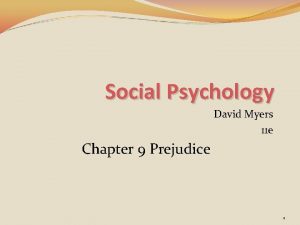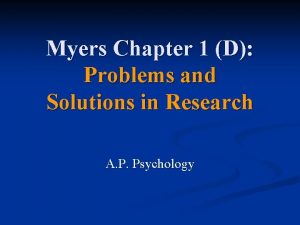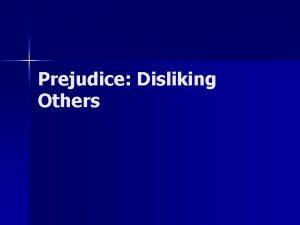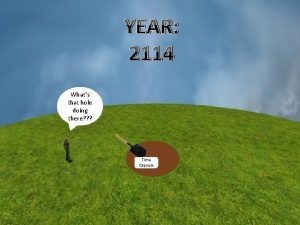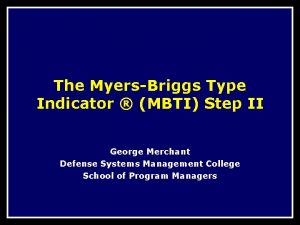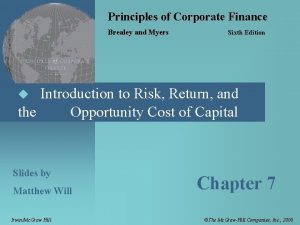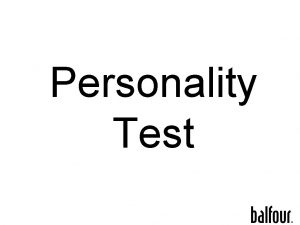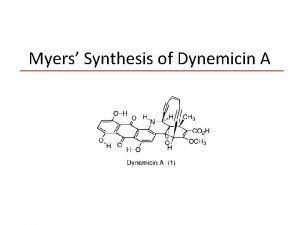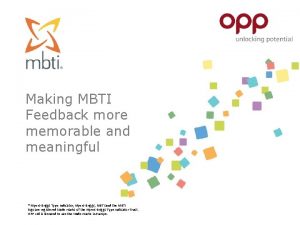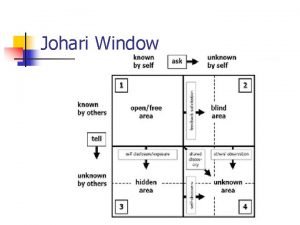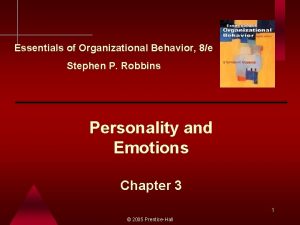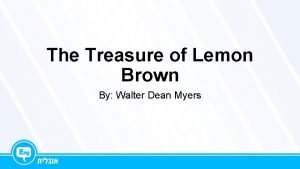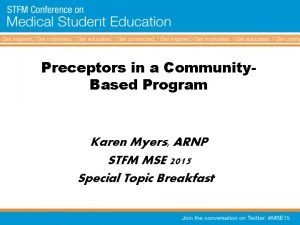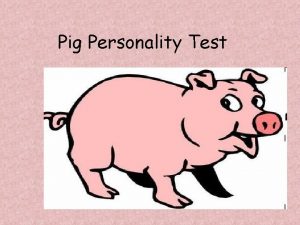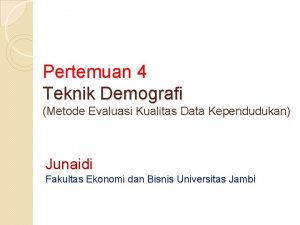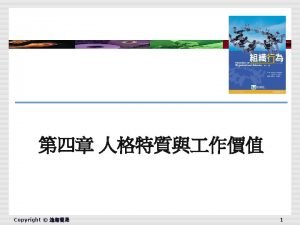Myers Psychology for AP David G Myers Power

























































































































- Slides: 121

Myers’ Psychology for AP* David G. Myers Power. Point Presentation Slides by Kent Korek Germantown High School Worth Publishers, © 2010 *AP is a trademark registered and/or owned by the College Board, which was not involved in the production of, and does not endorse, this product.

Unit 14: Social Psychology

Unit Overview • Social Thinking • Social Influence • Social Relations Click on the any of the above hyperlinks to go to that section in the presentation.

Introduction • Social Psychology – the scientific study of how we think about, influence, and relate to one another.

Social Thinking

Attributing Behavior to Persons or to Situations • Attribution theory – explain someone’s behavior by crediting either the situation or the person’s disposition. – Dispositional vs. situational attribution

Attributing Behavior to Persons or to Situations – Fundamental attribution error • the tendency for observers, when analyzing another’s behavior, to underestimate the impact of the situation and to overestimate personal disposition. – Self-serving bias

Attributing Behavior to Persons or to Situations The Effects of Attribution • Personal relationships • Political relationships • Job relationships

Attitudes and Actions • Attitude – feelings, often influenced by our beliefs, that predispose us to respond in a particular way to objects, people, and events.

Attitudes and Actions Central route persuasion attitude change in which interested people focus on the arguments and respond with favorable thoughts. Peripheral route Persuasion attitude change path in which people are influenced by incidental cues, such as a speaker’s attractiveness.

Attitudes and Actions Affect Attitudes • The Foot-in-the-Door Phenomenon – the tendency for people who have first agreed to a small request to comply later with a larger request. – “start small and build”

Attitudes and Actions Affect Attitudes • Role-Playing Affects Attitudes – Role • a set of expectations (norms) about a social position, defining how those in the position ought to behave. – Stanford prison study – Abu Ghraib

Attitudes and Actions Affect Attitudes • Cognitive Dissonance: Relief From Tension – Cognitive dissonance theory • theory that we act to reduce the discomfort (dissonance) we feel when two of our thoughts (cognitions) are inconsistent.

Social Thinking § Cognitive dissonance

Conformity and Obedience Group Pressure and Conformity

Social Influence

Conformity and Obedience Group Pressure and Conformity • Conformity – adjusting one’s behavior or thinking to coincide with a group standard. – Solomon Asch study

Conformity and Obedience Solomon Asch Study

Conformity and Obedience Group Pressure and Conformity • Conditions That Strengthen Conformity – One is made to feel incompetent or insecure – Group has at least three people – Group is unanimous – One admires the group’s status – One has made no prior commitment – Others in group observe one’s behavior – One’s culture strongly encourages respect for social standards

Conformity and Obedience Group Pressure and Conformity • Reasons for Conforming – Normative social influence • influence resulting from a person’s desire to gain approval or avoid disapproval.

Conformity and Obedience Group Pressure and Conformity • Reasons for Conforming – Informational social influence • influence resulting from one’s willingness to accept other’s opinions about reality.

Conformity and Obedience Group Pressure and Conformity

Conformity and Obedience • Obedience – Milgram’s studies on obedience • Procedure – Teacher & learner, teacher shocks • Results – 65% willing to deliver “lethal” shock • Ethics • Follow up studies

Conformity and Obedience

Conformity and Obedience

Conformity and Obedience

Conformity and Obedience

Conformity and Obedience Lessons From the Conformity and Obedience Studies • Ordinary people being corrupted by an evil situation

Group Influence Individual Behavior in the Presence of Others • Social Facilitation – stronger responses on simple or well-learned tasks in the presence of others. – Task difficulty – Expertise effects – more mastery = more recall, but only in context, can lead to false recall – Crowding effects – overcrowding = poorer performance

Group Influence Individual Behavior in the Presence of Others • Social Loafing – the tendency for people in a group to exert less effort when pooling their efforts toward attaining a common goal. – Reasons why? • Less accountability • View themselves as dispensable

Group Influence Individual Behavior in the Presence of Others • Deindividuation – the loss of self-awareness and self-restraint occurring in group situations that foster arousal and anonymity.

Group Influence Effects of Group Interaction • Group Polarization the enhancement of a group’s prevailing inclinations through discussion with the groups.

Group Influence Effects of Group Interaction • Group Polarization – the enhancement of a group’s prevailing inclinations through discussion with the groups.

Group Influence Effects of Group Interaction • Groupthink – the mode of thinking that occurs when the desire for harmony in a decision-making group overrides a realistic appraisal of alternatives

Individual Resistance – The Tank Man

Cultural Influence • Culture – the enduring behaviors, ideas, attitudes, values, and traditions shared by a group of people and transmitted from one generation to the next. – Culture within animals – Culture in humans

Cultural Influence Variations Across Cultures • Norm – an understood rule for accepted and expected behavior. Norms prescribe “proper” behavior. – Personal space • the buffer zone we like to maintain around our bodies. – Pace of life • siesta

Social Relations

Prejudice How Prejudiced Are People? • Prejudice • Stereotype • Discrimination

Prejudice How Prejudiced Are People?

Prejudice How Prejudiced Are People?

Prejudice How Prejudiced Are People?

Prejudice How Prejudiced Are People?

Prejudice How Prejudiced Are People?

Prejudice How Prejudiced Are People?

Prejudice Social Roots of Prejudice • Social Inequalities • Us and Them: Ingroup and Outgroup – Ingroup (Ingroup bias) – Outgroup • Emotional roots of prejudice – Scapegoat theory

Prejudice Cognitive Roots of Prejudice • Categorization – Outgroup homogeneity – Other-race effect • Vivid cases • Just-world phenomenon – Hindsight bias

Aggression • Aggression – any physical or verbal behavior intended to hurt or destroy.

Aggression The Biology of Aggression • Genetic Influences – Unknown – runs in families • Neural Influences – amygdala • Biochemical Influences – Testosterone & seratonin

Aggression Psychological and Social-Cultural Factors in Aggression • Aversive Events – Frustration-aggression principle • the principle that frustration creates anger, which can generate aggression. • Social and cultural influences – Aggression-replacement training • Focuses on adolsecents • Multimodal program

Aggression Psychological and Social-Cultural Factors in Aggression • Observing models of aggression – Rape myths • Acquiring social scripts • Do video games teach, or release violence? – Catharsis hypothesis?

Attraction The Psychology of Attraction • Proximity – Mere exposure effect • Phenomenon - repeated exposure to novel stimuli increases the liking of them. • Physical attractiveness • Similarity – Reward theory of attraction • we like those who like us and give us rewarding experiences

Attraction Romantic Love • Love – Passionate love • intense positive absorption in another, present at the beginning of a love relationship. – Companionate love • deep affectionate attachment felt for those with whom our lives are intertwined.

Attraction Romantic Love • Equity – condition in which people receive from a relationship in proportion to what they give to it. • Self-disclosure – revealing intimate aspects of oneself to others.

Altruism • Altruism – unselfish regard for the welfare of others. • Bystander Intervention – Diffusion of responsibility – Bystander effect • tendency for a bystander to be less likely to give aid if other bystanders are present. – Kitty Genovese

Altruism

Altruism

Altruism The Norms of Helping • Social exchange theory – social behavior - exchange process, aim is to maximize benefits and minimize costs. • Reciprocity norm – expectation that people will help, not hurt those who have helped them. • Social-responsibility norm – expectation that people will help those dependent upon them.

Conflict and Peacemaking • Conflict -perceived incompatibility of actions, goals, or ideas. • Social trap – Situation where conflicting parties, each pursuing their self-interest, get caught in mutually destructive behavior. – Non-zero sum game

Conflict and Peacemaking Enemy Perceptions • Mirror-image perceptions • Self-fulfilling prophecy

Conflict and Peacemaking • Contact • Cooperation – Superordinate goals • Communication • Conciliation – GRIT

The End

Conflict and Peacemaking Non-zero sum game – game where both players can win • prisoner's dilemma • Two accomplices are locked in separate cells. Each is offered three choices by the police: (1) if both confess to the charges, both will be jailed for five years, (2) if only one confesses, he will be freed but the non-confessor will be jailed for ten years, or (3) if neither confesses, both will be tried for a minor offense and will be jailed for one year.

Groups at School • • • • 1. Jocks – 2. Cheer – 3. Pom – 4. Drinkers – 5. Preppies – 6. Drama – 7. Brains – 8. Chorus – 9. Smokers – 10. Band – 11. Hipsters – 12. Rednecks – 13. Gamers – 14. Goth – 1 4. 75 4. 9 5. 55 5. 8 5. 9 6. 35 7. 75 7. 9 8. 25 9. 65 9. 7 12. 05 13. 5

• School Groups 5 th - sem. 1 12’ • • • • Jocks – 1. 14 Cheer – 2. 55 Preppies – 3. 55 Pom – 4. 11 Drama – 6. 44 Chorus 7. 05 Band – 7. 77 Drinkers– 8. 11 Skaters – 8. 5 Gamers – 8. 66 Druggies – 9. 22 Wankster – 9. 44 Rednecks – 10. 77 Emos/Goths– 13. 61

• • • • School groups - 5 th period – Sem. . 2 2006 1. Athletes/ jocks - 1. 1 2. Preppies - 2. 78 3. Cheerleaders - 2. 85 4. Pom - 4. 2 5. Wanksters / thugs - 6. 4 6. Brains - 7. 9 7. Chorus - 8. 07 Drama 9. Drinkers - 8. 1 10. Stoners - 8. 6 11. Skaters - 9. 85 12. Rednecks - 12. 1 13. Band - 12. 5 14. Goths / emos - 13. 2 15. Geeks - 13. 35

• • • • School groups - Period 6 – Sem. 1 2005 1. Athletes / jocks - 1. 2 2. Cheerleaders - 3. 1 3. Preppies - 3. 27 4. Drinkers - 5 5. Pom - 5. 6 6. Stoners - 6. 36 7. Skaters - 7. 9 8. Drama - 9 9. Choir - 10. 36 10. Goths / emos - 10. 8 11. Brains & wanksters - 10. 9 ( tie) 12. Rednecks - 11. 2 13. Slackers - 11. 7 14. Band - 13 15. Geeks / nerds - 14. 6

• Types of Files Teacher Information – This presentation has been saved as a “basic” Powerpoint file. While this file format placed a few limitations on the presentation, it insured the file would be compatible with the many versions of Powerpoint teachers use. To add functionality to the presentation, teachers may want to save the file for their specific version of Powerpoint. • Animation – Once again, to insure compatibility with all versions of Powerpoint, none of the slides are animated. To increase student interest, it is suggested teachers animate the slides wherever possible. • Adding slides to this presentation – Teachers are encouraged to adapt this presentation to their personal teaching style. To help keep a sense of continuity, blank slides which can be copied and pasted to a specific location in the presentation follow this “Teacher Information” section.

Teacher Information • Hyperlink Slides - This presentation contain two types of hyperlinks. Hyperlinks can be identified by the text being underlined and a different color (usually purple). – Unit subsections hyperlinks: Immediately after the unit title slide, a page (slide #3) can be found listing all of the unit’s subsections. While in slide show mode, clicking on any of these hyperlinks will take the user directly to the beginning of that subsection. This allows teachers quick access to each subsection. – Bold print term hyperlinks: Every bold print term from the unit is included in this presentation as a hyperlink. While in slide show mode, clicking on any of the hyperlinks will take the user to a slide containing the formal definition of the term. Clicking on the “arrow” in the bottom left corner of the definition slide will take the user back to the original point in the presentation. These hyperlinks were included for teachers who want students to see or copy down the exact definition as stated in the text. Most teachers prefer the definitions not be included to prevent students from only “copying down what is on the screen” and not actively listening to the presentation. For teachers who continually use the Bold Print Term Hyperlinks option, please contact the author using the email address on the next slide to learn a technique to expedite the returning to the original point in the presentation.

Teacher Information • Continuity slides – Throughout this presentation there are slides, usually of graphics or tables, that build on one another. These are included for three purposes. • By presenting information in small chunks, students will find it easier to process and remember the concepts. • By continually changing slides, students will stay interested in the presentation. • To facilitate class discussion and critical thinking. Students should be encouraged to think about “what might come next” in the series of slides. • Please feel free to contact me at kkorek@germantown. k 12. wi. us with any questions, concerns, suggestions, etc. regarding these presentations. Kent Korek Germantown High School Germantown, WI 53022 262 -253 -3400 kkorek@germantown. k 12. wi. us

Division title (green print) subdivision title (blue print) • xxx – xxx

Division title (green print) subdivision title (blue print) Use this slide to add a table, chart, clip art, picture, diagram, or video clip. Delete this box when finished

Definition Slide = add definition here

Definition Slides

Social Psychology = the scientific study of how we think about, influence, and relate to one another.

Attribution Theory = theory that we explain someone’s behavior by crediting either the situation or the person’s disposition.

Fundamental Attribution Error = the tendency for observers, when analyzing another’s behavior, to underestimate the impact of the situation and to overestimate the impact of personal disposition.

Attitude = feelings, often influenced by our beliefs, that predispose us to respond in a particular way to objects, people, and events.

Central Route Persuasion = attitude change in which interested people focus on the arguments and respond with favorable thoughts.

Peripheral Route Persuasion = attitude change path in which people are influenced by incidental cues, such as a speaker’s attractiveness.

Foot-in-the-Door Phenomenon = the tendency for people who have first agreed to a small request to comply later with a larger request.

Role = a set of expectations (norms) about a social position, defining how those in the position ought to behave.

Cognitive Dissonance Theory = theory that we act to reduce the discomfort (dissonance) we feel when two of our thoughts (cognitions) are inconsistent.

Conformity = adjusting one’s behavior or thinking to coincide with a group standard.

Normative Social Influence = influence resulting from a person’s desire to gain approval or avoid disapproval.

Informational Social Influence = influence resulting from one’s willingness to accept other’s opinions about reality.

Social Facilitation = stronger responses on simple or welllearned tasks in the presence of others.

Social Loafing = the tendency for people in a group to exert less effort when pooling their efforts toward attaining a common goal.

Deindividuation = the loss of self-awareness and selfrestraint occurring in group situations that foster arousal and anonymity.

Group Polarization = the enhancement of a group’s prevailing inclinations through discussion with the groups.

Groupthink = the mode of thinking that occurs when the desire for harmony in a decision-making group overrides a realistic appraisal of alternatives.

Culture = the enduring behaviors, ideas, attitudes, values, and traditions shared by a group of people and transmitted from one generation to the next.

Norm = an understood rule for accepted and expected behavior. Norms prescribe “proper” behavior.

Personal Space = the buffer zone we like to maintain around our bodies.

Prejudice = an unjustifiable (and usually negative) attitude toward a group and its members. Prejudice generally involves stereotyped beliefs, negative feelings, and a predisposition to discriminatory action.

Stereotype = a generalized (sometimes accurate but often overgeneralized) belief about a group of people.

Discrimination = unjustifiable negative behavior toward a group and its members.

Ingroup = “Us” – people with whom we share a common identity.

Outgroup = “Them” – those perceived as different or apart from our ingroup.

Ingroup Bias = the tendency to favor our own group.

Scapegoat Theory = theory that prejudice offers an outlet for anger by providing someone to blame.

Other-race Effect = the tendency to recall faces of one’s own race more accurately than faces of other races. Also called the cross-race effect and the own-race bias.

Just-World Phenomenon = the tendency for people to believe the world is just and that people therefore get what they deserve and deserve what they get.

Aggression = any physical or verbal behavior intended to hurt or destroy.

Frustration-aggression Principle = the principle that frustration – the blocking of an attempt to achieve some goal – creates anger, which can generate aggression.

Mere Exposure Effect = the phenomenon the repeated exposure to novel stimuli increases liking of them.

Passionate Love = an aroused state of intense positive absorption in another, usually present at the beginning of a love relationship.

Companionate Love = the deep affectionate attachment we feel for those with whom our lives are intertwined.

Equity = a condition in which people receive from a relationship in proportion to what they give to it.

Self-Disclosure = revealing intimate aspects of oneself to others.

Altruism = unselfish regard for the welfare of others.

Bystander Effect = the tendency for any given bystander to be less likely to give aid if other bystanders are present.

Social Exchange Theory = theory that our social behavior is an exchange process, the aim of which is to maximize benefits and minimize costs.

Reciprocity Norm = an expectation that people will help, not hurt those who have helped them.

Social-Responsibility Norm = an expectation that people will help those dependent upon them.

Conflict = a perceived incompatibility of actions, goals, or ideas.

Social Trap = a situation in which the conflicting parties, by each rationally pursuing their selfinterest, become caught in mutually destructive behavior.

Mirror-Image Perceptions = mutual views held by conflicting people, each side sees itself as ethical and peaceful and the other side as evil and aggressive.

Self-Fulfilling Prophecy = a belief that leads to its own fulfillment.

Superordinate Goals = shared goals among people and require their cooperation.

GRIT = Graduated and Reciprocated Initiatives in Tension-Reduction – strategy designed to decrease international tensions.
 Psychology ninth edition david g myers
Psychology ninth edition david g myers Psychology eighth edition david g myers
Psychology eighth edition david g myers Psychology eighth edition david g myers
Psychology eighth edition david g myers General adaptation syndrome
General adaptation syndrome Psychology tenth edition david g myers
Psychology tenth edition david g myers Social psychology david myers
Social psychology david myers Myers ap psychology unit 8
Myers ap psychology unit 8 Tutored human enrichment
Tutored human enrichment Myers' psychology for ap solutions
Myers' psychology for ap solutions Psychology in everyday life myers
Psychology in everyday life myers Myers' psychology for ap
Myers' psychology for ap Draw power triangle
Draw power triangle Formuö
Formuö Typiska novell drag
Typiska novell drag Tack för att ni lyssnade bild
Tack för att ni lyssnade bild Returpilarna
Returpilarna Varför kallas perioden 1918-1939 för mellankrigstiden
Varför kallas perioden 1918-1939 för mellankrigstiden En lathund för arbete med kontinuitetshantering
En lathund för arbete med kontinuitetshantering Särskild löneskatt för pensionskostnader
Särskild löneskatt för pensionskostnader Tidbok
Tidbok Sura för anatom
Sura för anatom Förklara densitet för barn
Förklara densitet för barn Datorkunskap för nybörjare
Datorkunskap för nybörjare Boverket ka
Boverket ka Debattinlägg mall
Debattinlägg mall Delegerande ledarstil
Delegerande ledarstil Nyckelkompetenser för livslångt lärande
Nyckelkompetenser för livslångt lärande Påbyggnader för flakfordon
Påbyggnader för flakfordon Kraft per area
Kraft per area Publik sektor
Publik sektor Urban torhamn
Urban torhamn Presentera för publik crossboss
Presentera för publik crossboss Jiddisch
Jiddisch Kanaans land
Kanaans land Treserva lathund
Treserva lathund Mjälthilus
Mjälthilus Bästa kameran för astrofoto
Bästa kameran för astrofoto Cks
Cks Lågenergihus nyproduktion
Lågenergihus nyproduktion Bra mat för unga idrottare
Bra mat för unga idrottare Verktyg för automatisering av utbetalningar
Verktyg för automatisering av utbetalningar Rutin för avvikelsehantering
Rutin för avvikelsehantering Smärtskolan kunskap för livet
Smärtskolan kunskap för livet Ministerstyre för och nackdelar
Ministerstyre för och nackdelar Tack för att ni har lyssnat
Tack för att ni har lyssnat Referatmarkeringar
Referatmarkeringar Redogör för vad psykologi är
Redogör för vad psykologi är Stål för stötfångarsystem
Stål för stötfångarsystem Atmosfr
Atmosfr Borra hål för knoppar
Borra hål för knoppar Orubbliga rättigheter
Orubbliga rättigheter Fr formel
Fr formel Tack för att ni har lyssnat
Tack för att ni har lyssnat Steg för steg rita
Steg för steg rita Verksamhetsanalys exempel
Verksamhetsanalys exempel Tobinskatten för och nackdelar
Tobinskatten för och nackdelar Toppslätskivling effekt
Toppslätskivling effekt Handledning reflektionsmodellen
Handledning reflektionsmodellen Egg för emanuel
Egg för emanuel Elektronik för barn
Elektronik för barn Plagg i gamla rom
Plagg i gamla rom Strategi för svensk viltförvaltning
Strategi för svensk viltförvaltning Var 1721 för stormaktssverige
Var 1721 för stormaktssverige Ellika andolf
Ellika andolf Romarriket tidslinje
Romarriket tidslinje Tack för att ni lyssnade
Tack för att ni lyssnade Vilka tal pekar pilarna på
Vilka tal pekar pilarna på Klassens frånvaro rim
Klassens frånvaro rim Inköpsprocessen steg för steg
Inköpsprocessen steg för steg Rbk mätning
Rbk mätning Etik och ledarskap etisk kod för chefer
Etik och ledarskap etisk kod för chefer Kolposkopi, px
Kolposkopi, px Myndigheten för delaktighet
Myndigheten för delaktighet Trög för kemist
Trög för kemist Tillitsbaserad ledning
Tillitsbaserad ledning Läkarutlåtande för livränta
Läkarutlåtande för livränta Brunn karttecken
Brunn karttecken Ramsa geometriska former
Ramsa geometriska former Vishnuismen
Vishnuismen Mitos steg
Mitos steg Bris för vuxna
Bris för vuxna Jätte råtta
Jätte råtta Lewis terman ap psychology definition
Lewis terman ap psychology definition Positive psychology ap psychology definition
Positive psychology ap psychology definition Aggressive role
Aggressive role Social psychology ap psychology
Social psychology ap psychology Introspection method of psychology
Introspection method of psychology Social psychology definition psychology
Social psychology definition psychology Health psychology definition ap psychology
Health psychology definition ap psychology David power liverpool
David power liverpool Nature and power of prejudice
Nature and power of prejudice Walter dean myers
Walter dean myers Bad boy walter dean myers summary
Bad boy walter dean myers summary Mr irwin lasher
Mr irwin lasher Mbti step iii
Mbti step iii Binary counting sequence
Binary counting sequence Finance brealey and myers
Finance brealey and myers Myers pig personality test
Myers pig personality test Achilles mbti
Achilles mbti Andrew myers chemistry
Andrew myers chemistry Monster by walter dean myers vocabulary
Monster by walter dean myers vocabulary Monster walter dean myers vocabulary
Monster walter dean myers vocabulary Lucky paradise mbti
Lucky paradise mbti Humanmetrics mbti
Humanmetrics mbti Tony robbins myers briggs
Tony robbins myers briggs Drexel university myers hall
Drexel university myers hall Leslie the bridge to terabithia
Leslie the bridge to terabithia 5 voices summary
5 voices summary Gruneberg and myers
Gruneberg and myers Bad boy walter dean myers
Bad boy walter dean myers Tipos de personalidad
Tipos de personalidad The treasure of lemon brown plot
The treasure of lemon brown plot The treasure of lemon brown by walter dean myers
The treasure of lemon brown by walter dean myers Aarian afshari
Aarian afshari Draw pig personality test
Draw pig personality test Myers briggs typenindikator
Myers briggs typenindikator Determinants of corporate borrowing
Determinants of corporate borrowing Indeks myers adalah
Indeks myers adalah Mbti p
Mbti p Myers briggs color wheel
Myers briggs color wheel Bad boy by walter dean myers
Bad boy by walter dean myers Myers–briggs type indicator
Myers–briggs type indicator





